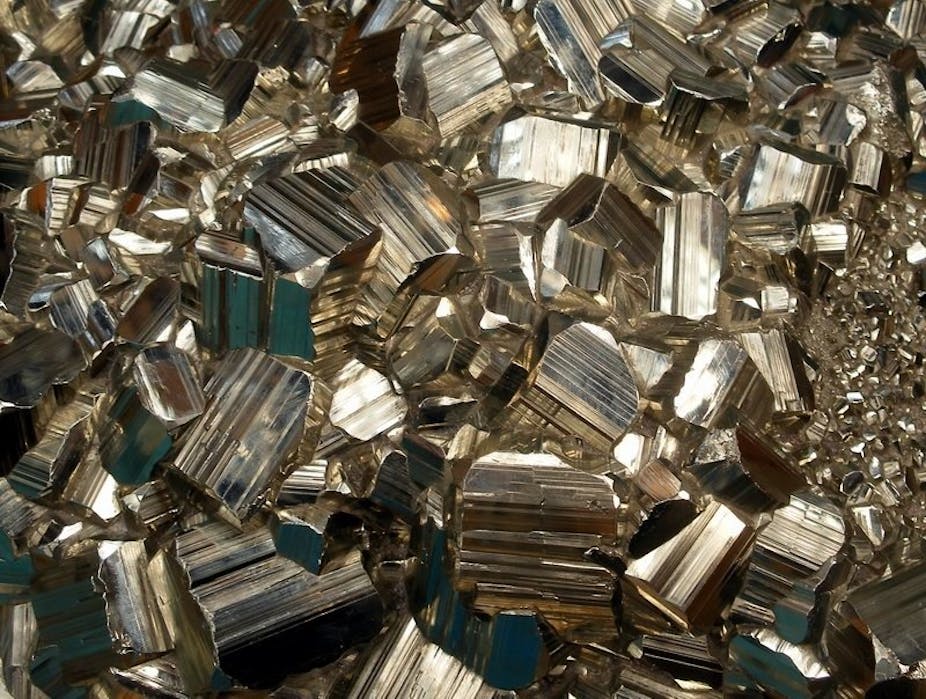We are now looking forward to a low-carbon society where fossil fuels are at least partially replaced with renewable sources of energy such as solar, wind, geo-thermal and tidal. Fossil fuels are a finite resource, as is the amount of greenhouse gases the planet’s atmosphere can absorb before instigating catastrophic climate change which switching to renewables is intended to avoid.
But, as we have argued recently in the journal Nature, by building solar panels and wind turbines in great numbers to replace the power of coal, oil and gas, we are swapping one set of finite limitations for another: metal.
Currently wind and solar provide only about 1% of global energy, but this contribution is expected to increase from 400 terawatt-hours (TWh) to 25,000TWh in 2050. Since most renewable energy sources are diffuse and intermittent, to harness large amounts of this energy requires complex infrastructure distributed over large areas.
This requires large amounts of metals and minerals. To produce equivalent power to that generated by fossil fuels or nuclear power stations, solar and wind require up to 90 times more aluminium, 50 times more iron, copper and glass, and 15 times more concrete. Also needed is the sand and industrial minerals necessary to make concrete and glass, and resins and plastics derived from hydrocarbons.
These materials will be tied up for 10-20 years, and won’t be available for recycling until whatever solar panel or wind turbine they were turned into is retired. About 3,200m tonnes of steel, 310m tonnes of aluminium and 40m tonnes of copper will be required to construct the energy infrastructure needed to generate the expected 25,000TWh. In the next 40 years, the annual global demand for these elements will rise by 5-18% of the world supply in 2010; an increase equivalent to the demand from all industrial sectors between 1970-2000. The anticipated demand for minor metals, used extensively in the green energy sector, is more worrying: between 2010-2030, the annual global demand for the elements gallium, indium, selinium, tellurium and rare earths to manufacture solar panels and wind turbines will increase by the equivalent of between 10-230% of the world supply.
Renewable energy’s demand for raw materials will also compete with other industries, as new technologies used in the IT, transport and green energy sectors require a wide set of previously little-used and generally rare metals. Additionally, 10% of the world’s current energy consumption is spent on extracting and processing these mineral resources.
Without extraordinary advances in mining and refining technology, this process is likely to get more energy intensive as miners turn to less accessible or poorer quality deposits. As the huge amounts of energy needed will initially come from fossil fuels, there is a risk that the transfer to renewable energy will be hampered by competition for limited metals and fossil energy that are already becoming more difficult, and more expensive, to secure.
Sharing the mineral wealth
What should be done to address these problems? The transition to renewable energy can only work if all resources are managed globally, simultaneously. Earth is rich in resources, but they are finite. Growing demand will force us to fully acknowledge the inherent trade-off between the co-production of metals and energy, and to optimise the way we go about it to use both as efficiently as possible. This will require a co-ordinated effort involving scientists from various disciplines (earth and environmental sciences, material sciences, economy, social sciences), engineers and the industrial base. It will be important to build into future plans the environmental and energy costs of construction, the use and recycling of the necessary production infrastructure, and the distribution and storage of renewable energy and rare metals.
When new products are designed, from the outset their designers will need to take into account the realities of mineral supply by developing technologies using less or no rare elements (substitution). They will need to integrate the recycling of the end product into its raw materials, and any waste generated throughout the product’s entire life cycle. This has already begun to take place, for example in terms of electronic waste, where take-back schemes require the manufacturers to deal with recycling end-of-life products. But it must go far further, and in many more areas of business and industry.
The dependence on foreign metal imports should also be considered – most developed nations import their minerals from abroad. European industries consume more than 20% of the world’s metals, yet the European domestic production of metals is less than 5% of the global production. This situation is highly unsatisfactory for security, economic and ethical reasons and makes European industry vulnerable to supply restrictions.
Green technologies should incorporate domestic and controlled mining which reduces the financial and environmental costs of transporting metals from far-flung sources and decreases the carbon footprint, while providing jobs and wealth to the local community. Currently, much of the pollution associated with mining is outsourced to regions where the environmental impact is often uncontrolled. In Europe, things can and must be done better.

